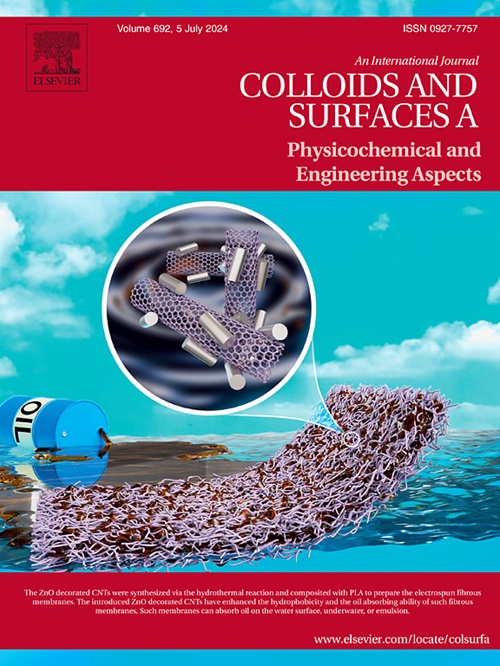Efficient photocatalytic degradation of 2,4,6-trichlorophenol by Z-scheme α-MnO2/Bi2S3 enriched with double vacancies under visible light: Mechanism and degradation pathway
IF 4.9
2区 化学
Q2 CHEMISTRY, PHYSICAL
Colloids and Surfaces A: Physicochemical and Engineering Aspects
Pub Date : 2025-04-27
DOI:10.1016/j.colsurfa.2025.137059
引用次数: 0
Abstract
The widespread use and release of 2,4,6-Trichlorophenol (TCP) poses a significant risk to water bodies and ecosystems. Designing efficient and stable catalysts for photocatalytic degradation of TCP remains a great challenge. In this paper, a Z-scheme α-MnO2/Bi2S3 (Mn/Bi) composite enriched with oxygen (OVs) and sulfur (SVs) vacancies is designed for photocatalytic degradation of TCP. 60-Mn/Bi achieved 88 % degradation efficiency for 20 mg/L TCP solution. The reaction rate (k) of 60-Mn/Bi is 6.46 and 4.41 times higher than that of α-MnO2 and Bi2S3, respectively. The catalyst exhibited high catalytic activity in a wide pH range and high resistance to anion. In addition, the cycling performance of 60-Mn/Bi is relatively stable, and the ion leaching rate is low. The Z-scheme mechanism is confirmed by characterization and DFT, which effectively retained the strong redox capacity. The abundant vacancy structure enhances the adsorption of TCP and promotes the migration of photogenerated carriers. In addition, the rod-shaped Bi2S3 provides a carrier for α-MnO2 nanoparticles, which effectively alleviates agglomeration and thus exposes more active sites. Three possible degradation pathways were explored by LC-MS and DFT. This study provides a facile method and guidance for the preparation of Z-scheme catalysts to improve photocatalytic degradation performance.
富双空位的Z-scheme α-MnO2/Bi2S3在可见光下高效光催化降解2,4,6-三氯苯酚:机理和降解途径
2,4,6-三氯苯酚(TCP)的广泛使用和释放对水体和生态系统构成了重大风险。设计高效、稳定的光催化降解TCP催化剂仍然是一个巨大的挑战。本文设计了一种富含氧(OVs)和硫(SVs)空位的Z-scheme α-MnO2/Bi2S3 (Mn/Bi)复合材料,用于光催化降解TCP。60-Mn/Bi对20 mg/L TCP溶液的降解效率达到88 %。60-Mn/Bi的反应速率(k)分别是α-MnO2和Bi2S3的6.46和4.41倍。该催化剂在较宽的pH范围内表现出较高的催化活性和对阴离子的抗性。此外,60 mn /Bi的循环性能相对稳定,离子浸出率较低。表征和DFT证实了Z-scheme机制,有效地保留了强氧化还原能力。丰富的空位结构增强了TCP的吸附,促进了光生载流子的迁移。此外,棒状Bi2S3为α-MnO2纳米颗粒提供了载体,有效地缓解了团聚,从而暴露出更多的活性位点。通过LC-MS和DFT探索了三种可能的降解途径。本研究为制备提高光催化降解性能的z型催化剂提供了简便的方法和指导。
本文章由计算机程序翻译,如有差异,请以英文原文为准。
求助全文
约1分钟内获得全文
求助全文
来源期刊
CiteScore
8.70
自引率
9.60%
发文量
2421
审稿时长
56 days
期刊介绍:
Colloids and Surfaces A: Physicochemical and Engineering Aspects is an international journal devoted to the science underlying applications of colloids and interfacial phenomena.
The journal aims at publishing high quality research papers featuring new materials or new insights into the role of colloid and interface science in (for example) food, energy, minerals processing, pharmaceuticals or the environment.

 求助内容:
求助内容: 应助结果提醒方式:
应助结果提醒方式:


